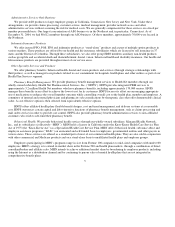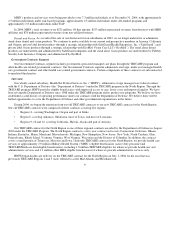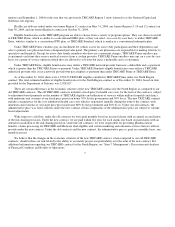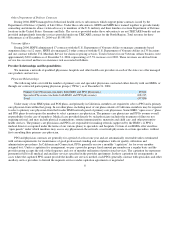Health Net 2004 Annual Report Download - page 18
Download and view the complete annual report
Please find page 18 of the 2004 Health Net annual report below. You can navigate through the pages in the report by either clicking on the pages listed below, or by using the keyword search tool below to find specific information within the annual report.
•
procedures for review of quality assurance,
•
enrollment requirements,
•
composition of policy-making bodies to assure that plan members have access to representation,
•
procedures for resolving grievances,
•
the interrelationship between HMOs and their health care providers,
•
adequacy and accessibility of the network of health care providers,
•
timely and accurate payment of provider claims,
•
provision of services that are culturally and linguistically accessible, and
On September 28, 2000, Assembly Bill 1455 (“AB 1455”) was signed into law. AB 1455 amended and added several sections to
the Knox-Keene Act. For example, AB 1455 increased the interest rate that health care service plans must pay on uncontested claims
not paid promptly within the required time period and granted the DMHC additional authority to impose monetary penalties and other
sanctions on health plans engaging in certain “unfair payment practices” (as defined in AB 1455). As required by AB 1455, the
DMHC adopted final regulations addressing both claims reimbursement and provider dispute resolution procedures. The DMHC
advised health care service plans to implement them for all services provided on and after January 1, 2004.
Any material modifications to the organization or operations of HN California and MHN are subject to prior review and
approval by the DMHC. This approval process can be lengthy and there is no certainty of approval. Other significant changes require
filing with the DMHC, which may then comment and require changes. In addition, under the Knox-Keene Act, HN California and
MHN must file periodic reports with, and are subject to periodic review and investigation by, the DMHC. Non-compliance with the
Knox-Keene Act, including the provisions added and amended by AB 1455, may result in an enforcement action, fines and penalties,
and, in the most severe cases, limitations on or revocation of the Knox-Keene license.
Other Laws and Regulations
•
initial and continuing financial viability of the HMO and its risk-bearing providers.
In each state in which our HMO and insurance subsidiaries (collectively, “regulated subsidiaries”) do business, our regulated
subsidiaries must meet numerous state licensing criteria and secure the approval of state licensing authorities before implementing
certain operational changes, including the development of new product offerings and, in some states, the expansion of service areas.
State departments of insurance (“DOIs”) regulate our insurance business under various provisions of state insurance codes and
regulations. To remain licensed, each regulated subsidiary must continue to comply with state laws and regulations and may from
time to time be required to change services, procedures or other aspects of its operations to comply with changes in applicable laws
and regulations. In addition, regulated subsidiaries must file periodic reports with, and their operations are subject to periodic
examination by, state licensing authorities. Our regulated subsidiaries are required by state law to meet certain minimum capital and
deposit and/or reserve requirements in each state and may be restricted from paying dividends to their parent corporations under some
circumstances. For additional information regarding our regulated subsidiaries’ statutory capital requirements see “Management’s
Discussion and Analysis of Financial Condition and Results of Operations—Statutory Capital Requirements.” Several states have
increased minimum capital requirements, in response to proposals by the National Association of Insurance Commissioners to
institute risk- based capital requirements. Regulations in these and other states may be changed in the future to further increase capital
requirements. Such increases could require us to contribute additional capital to our regulated subsidiaries. Any adverse change in
governmental regulation or in the regulatory climate in any state could materially impact the regulated subsidiaries operating in that
state. The HMO Act and state laws place various restrictions on the ability of our regulated subsidiaries to price their products freely.
We must comply with applicable provisions of state insurance and similar laws, including regulations governing our ability to seek
ownership interests in new HMOs, PPOs and insurance companies, or otherwise expand our geographic markets or diversify our
product lines.
15
























